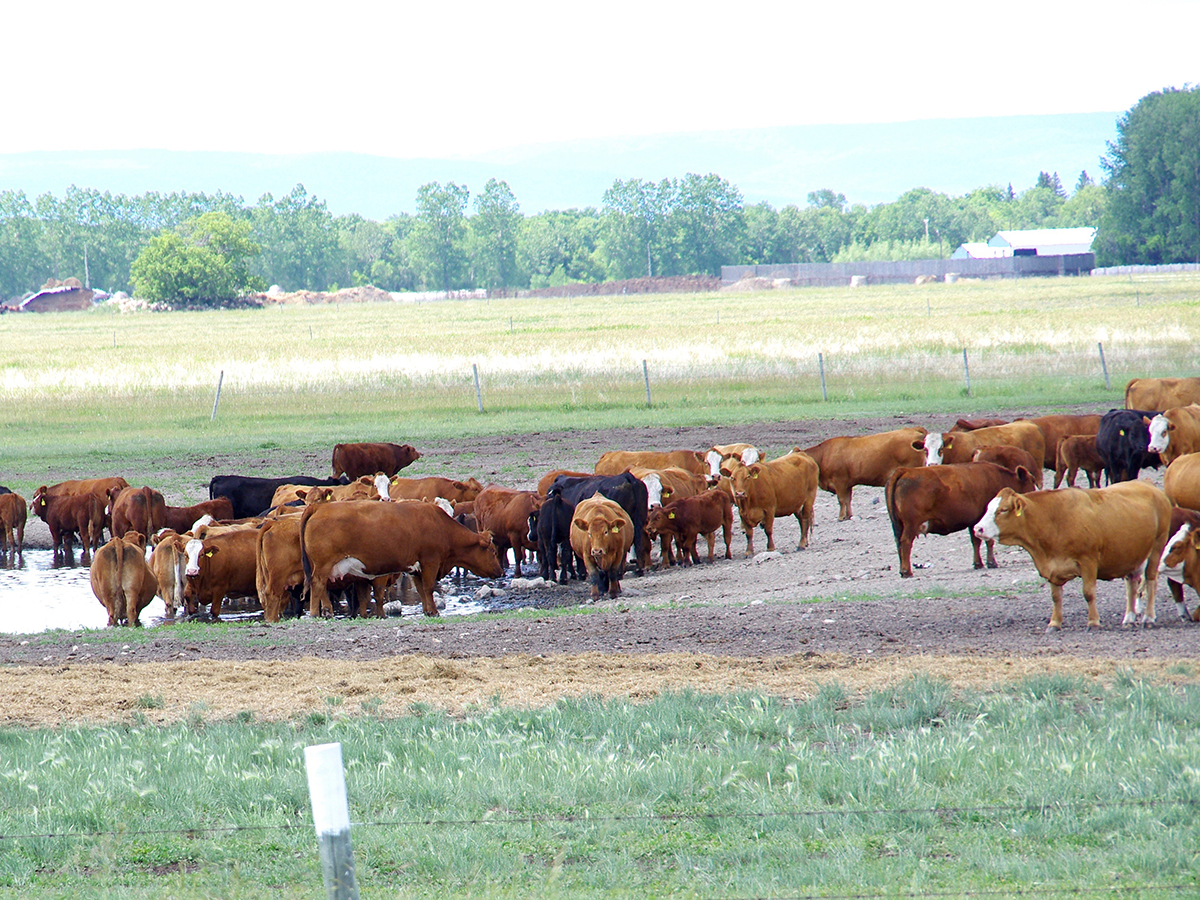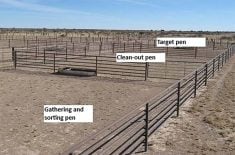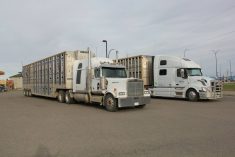Receiving the call that a bovine tuberculosis infection has been linked to one’s cattle herd is tough to receive. But even worse is the call that one’s herd has tested positive for the infection.
“It’s very important to acknowledge that when a premise is identified as infected, it’s confirmed infected,” said Allison Danyluk Ross, a Canadian Food Inspection Agency regional veterinary officer.
“That’s a significant impact to that producer. That is an absolutely devastating phone call to get from me, I realize that.”
Read Also

Quebec pork company calls for transparency around gene-edited pigs
Quebec-based pork company duBreton is calling for transparency around meats from gene-edited pigs on concerns that a lack of mandatory labelling will confuse consumers, and dilute certification claims. The organic sector is also calling for labelling rules.
At the Saskatchewan Beef Industry Conference in Saskatoon Jan. 30, Danyluk Ross gave attending producers a run through of how the bovine TB investigation process works. The outreach is to help producers better understand what’s involved in the National Bovine Tuberculosis Eradication Program so that if they find themselves in that situation, they can know what to expect.
Bovine TB is rare in Canada, occurring at a prevalence of less than 0.01 per cent. However, it can affect cattle and other livestock, wildlife and even people. And when it’s identified, there is a significant impact to the producer and any other producers with herds in proximity.
The disease is slow moving, taking up to five years to present itself in an animal. From the time of initial infection, it can grow in the body and spread to other animals in close proximity.
Clinical signs of the disease are not typically noticed by the producer, which is why slaughter surveillance is the primary method of finding the infection. At slaughter it can be found in the form of a granuloma, which is typically small in size but can grow and has a gritty texture when found in cattle.
Slaughter surveillance is a key component due to the high number of animals processed each year and the fact that at any stage of the infection, testing is not 100 per cent accurate.
When a granuloma is detected, the investigation into the suspect case begins.
Investigation steps
The CFIA traces the animal back to its originating herd and premises, both of which then undergo testing. Movement controls and biosecurity and bio-containment are implemented, putting in place quarantine zones similar to the procedures for avian influenza and African swine fever, to ensure trade can continue in other areas of the province and country.
As well, there is contact tracing of people, other animals and locations that have been involved.
Testing of premises is an important part of identifying the level of infection and to determine if any other areas are involved. If bovine TB is not detected, then the CFIA considers other locations the animal could have contracted the disease, such as other yards or through wildlife contact.
Three animal tests are available:, caudal fold tuberculin (CFT), Bovigam and ELISA (enzyme-linked immunosorbent assay). Danyluk Ross said that of the three, the CFIA has only been recently using the CFT and Bovigam tests because ELISA hasn’t been particularly effective.
CFT works through injection of tuberculin at the base of the tail and then waiting three days to see if there’s been a reaction. Bovigam is a blood test used to measure the immune response to tuberculosis bacteria in the body.
“There’s a little bit of a gap at the beginning where (the CFT test) is not able to pick up, and that’s where the Bovigam test comes in. It can pick up the infection a little bit earlier than the caudal fold test,” she said.
Once the animals that react have been identified, they are euthanized. While a reaction doesn’t automatically equate to being positive for bovine TB, it does mean the animal has signs of exposure and infection. An enhanced postmortem examination of tissue from lymph nodes and other organs are sent to the lab to undergo histopathology and acid-fast staining to determine if the animal was positive.
However, it’s not confirmed until a bacteria culture is taken and a polymerase chain reaction (PCR) is done.
“We can take the bacteria that we grow on the culture and we can figure out what strain of TB we got. And that’s pretty important to try and figure out where it came from — is it related to a past case, that type of thing. The unfortunate part about culture, it takes a long time to get the results — up to 16 weeks,” she said.
And that’s where the PCR comes in. It provides final results in a maximum of two weeks.
While testing is underway, CFIA is also working on identifying points of contact and finding the trace-ins and trace-outs — everything from where animals were bought or sold to any fenceline sharing, community pasture use, mixing of herds and shared bulls.
This falls under the category of the epidemiological investigation, which also includes looking into herd management methods, who has been in contact with the animals and wildlife surveillance testing.
Tracing is one of the more difficult pieces because of operation variability. All means of tracking contact is used, as well as any possible help — brand inspectors, manifests, auction records, personal brands, farm tags, receipts of purchase and any other paperwork a producer can provide.
The CFIA traces all points of contact from the past five years, so it’s essential that farmers keep good, accurate records and ensure that paperwork is always filled out properly.
Once all testing and tracing are finished, and the premises has been confirmed as the location of bovine TB, then the herd is depopulated.
“After depopulation is cleaning and disinfection, followed by a 45-day vacancy period,” Danyluck Ross said.
“And then the producer would be allowed to restock. And we will do testing after the premises is restocked, just to confirm the disease didn’t escape us somehow and remain on the premises.”
If a producer opts to not clean and disinfect, because it’s costly and done at their own expense, the operation must sit dormant for two years before restocking and retesting.
Provincial supports
Bovine TB investigations occur at the federal level — the province has no direct involvement. However, Saskatchewan Agriculture is looking for ways to be more available to affected producers.
Following the 2023 outbreak, the province performed outreach to gain a clearer understanding of producers’ feelings and experiences regarding the disease. What they found was a lack of clarity surrounding TB policies, inefficient advocacy and significant mental health impacts due to additional pressures, fears and stressors.
Producers talked about financial burdens, feeling of isolation, stigma of the investigation and not knowing who to contact for support or assistance.
“I’m really grateful for them (producers) … for sharing their stories with us and talking to us about the challenges that they experienced and the impacts because I think it has showed us some opportunities to make some changes,” said Stephanie Smith, Saskatchewan’s chief veterinary officer.
The province intends to take on an “industry liaison position” to better support producers and other impacted people, as well as provide advocacy. It is educating itself on the investigation process so that it can provide better education and insight when producers have questions.
However, it’s important for farmers and ranchers to do their own research. Because there’s no preventive measure to take, or ways to identify the source, the most beneficial approach is preparedness. Learn the key information, try to understand the process and ask questions — know the basics before having to deal with it.
Smith said producers can reach out to the province so they can have someone in the room to provide clarity and support to ask why something is happening.
“It’s having somebody there that is not directly impacted, that can think about this critically, that could question ‘why,’ that can support you through that whole process,” she said.
“So, I hope that does help — at least with part of this.”
The other thing producers can do is speak up and advocate for themselves and the industry. Smith encouraged attendees to share their ideas and push for change, especially on the innovation and financial side.
“Compensation regulations are very, very challenging to change, and those things are not quick,” she said.
“So we’re already looking at our avenue (provincially).
“But I think there’s also room here for the association and the individual producer to speak up, think about alternatives and look at what should be a better system around financial supports.”
She said nothing is foolproof, even if there are important reasons for the way things are such as trade and export reliance, public health and animal health.
“We don’t want to be stuck in the same policies just because it’s the way we’ve done things. I think it’s very appropriate to question ‘why’ and look at whether we can do something differently.”
Producers who are affected by a bovine TB investigation, or dealing with other pressures and stress in agriculture, can contact the provincial agriculture ministry, the Do More Agriculture Foundation or SaskAgMatters. All discussions are confidential and privacy is secured.


















